2023届高考英语外刊阅读模拟强化训练: 阅读理解专题十八(含答案)
文档属性
| 名称 | 2023届高考英语外刊阅读模拟强化训练: 阅读理解专题十八(含答案) | 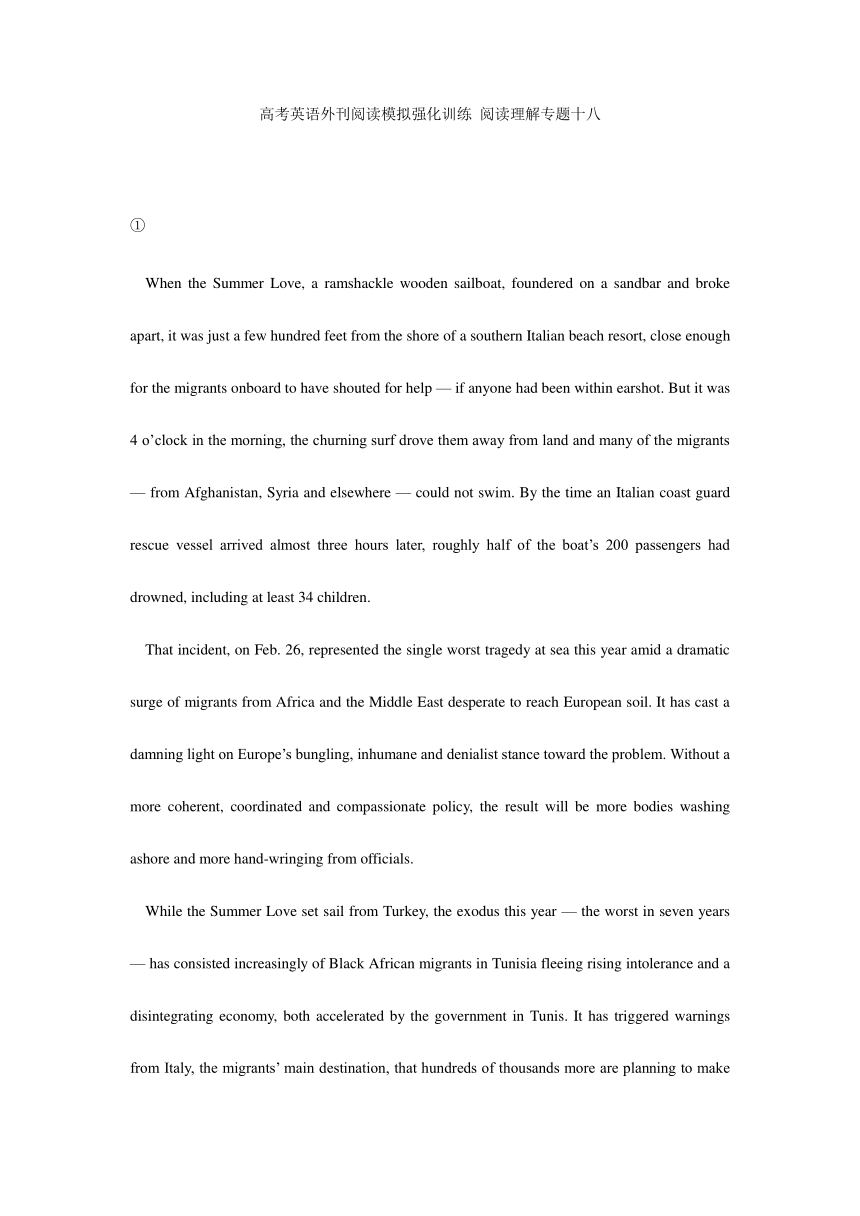 | |
| 格式 | docx | ||
| 文件大小 | 24.0KB | ||
| 资源类型 | 教案 | ||
| 版本资源 | 通用版 | ||
| 科目 | 英语 | ||
| 更新时间 | 2023-04-21 19:30:13 | ||
图片预览

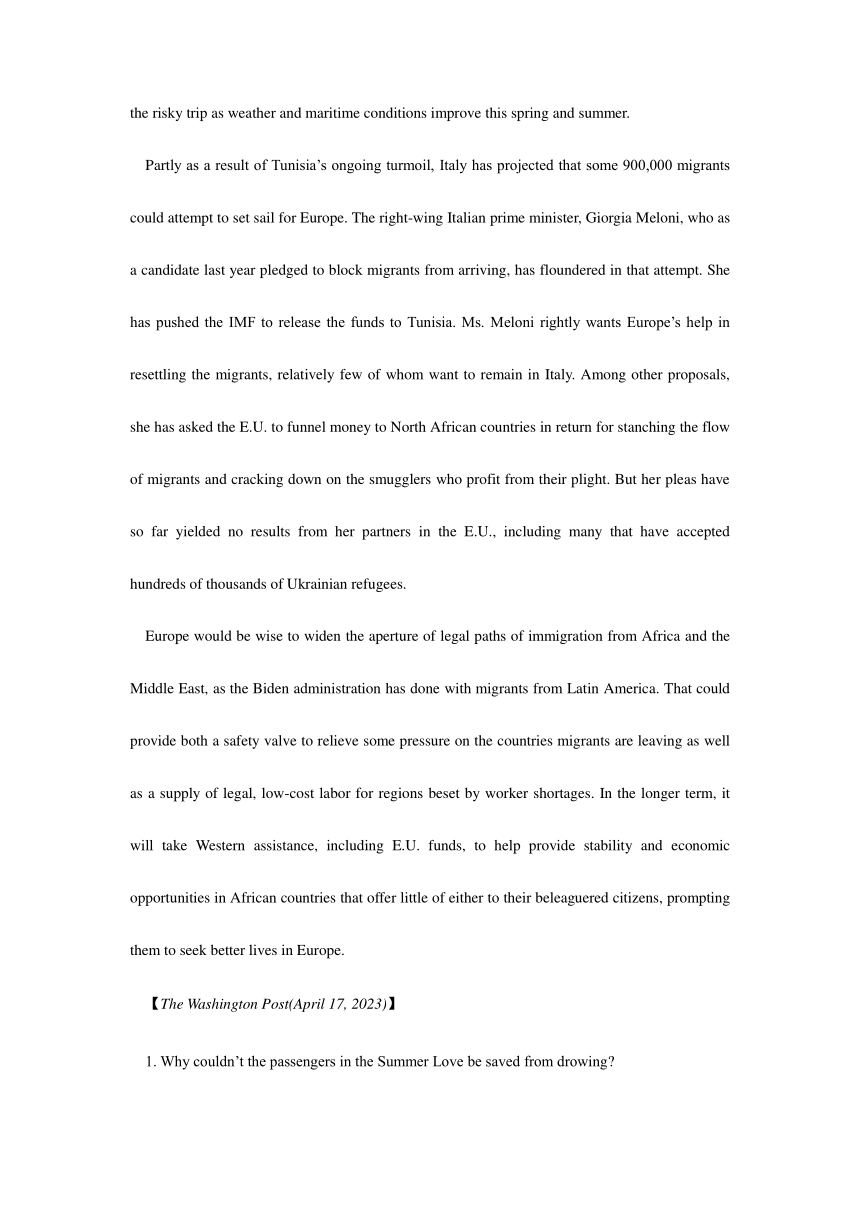
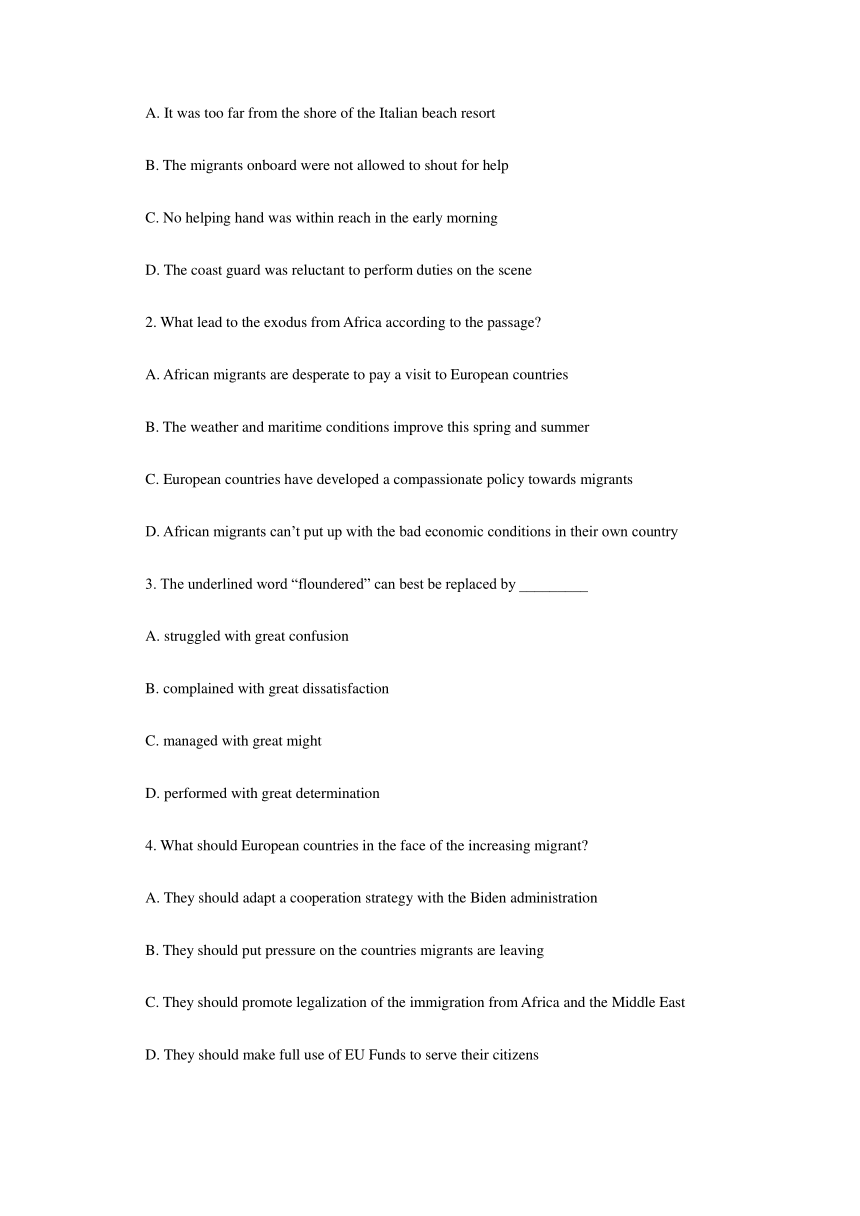
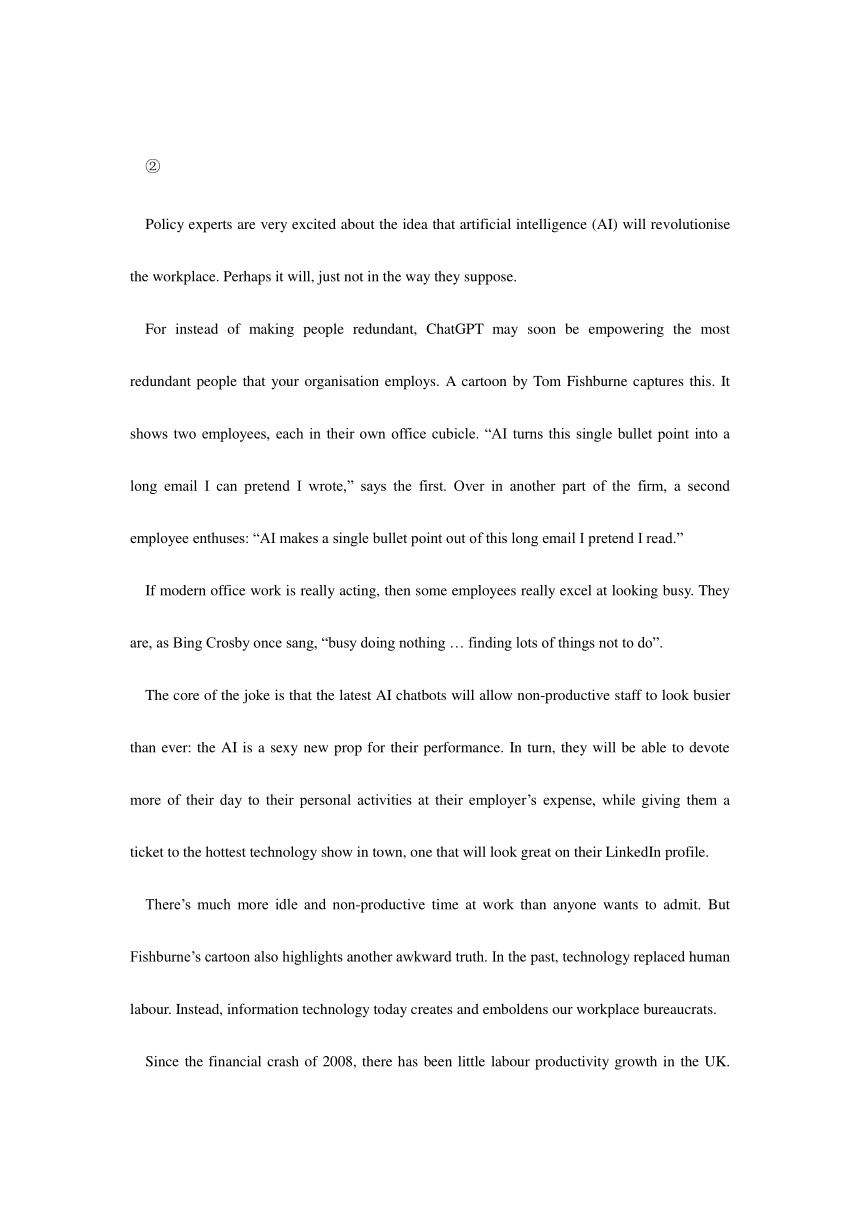
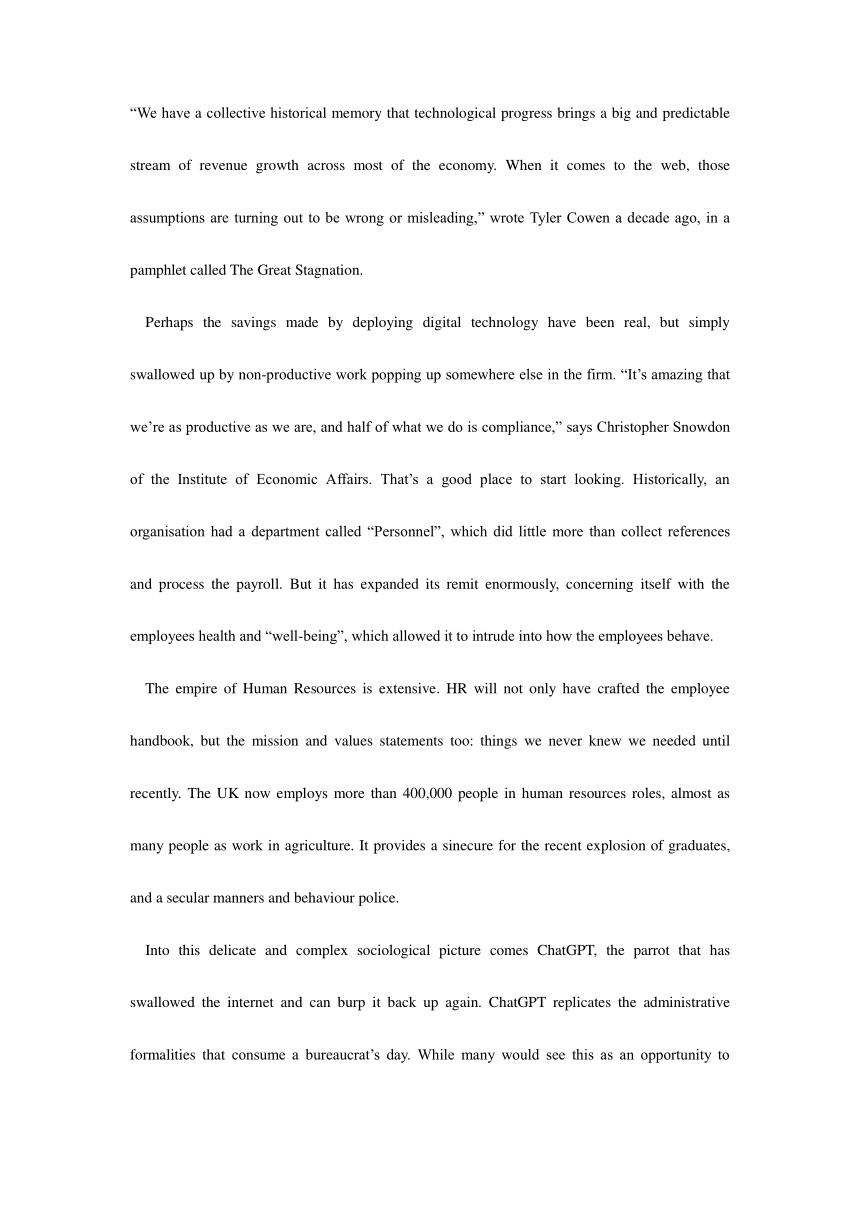
文档简介
高考英语外刊阅读模拟强化训练 阅读理解专题十八
①
When the Summer Love, a ramshackle wooden sailboat, foundered on a sandbar and broke apart, it was just a few hundred feet from the shore of a southern Italian beach resort, close enough for the migrants onboard to have shouted for help — if anyone had been within earshot. But it was 4 o’clock in the morning, the churning surf drove them away from land and many of the migrants — from Afghanistan, Syria and elsewhere — could not swim. By the time an Italian coast guard rescue vessel arrived almost three hours later, roughly half of the boat’s 200 passengers had drowned, including at least 34 children.
That incident, on Feb. 26, represented the single worst tragedy at sea this year amid a dramatic surge of migrants from Africa and the Middle East desperate to reach European soil. It has cast a damning light on Europe’s bungling, inhumane and denialist stance toward the problem. Without a more coherent, coordinated and compassionate policy, the result will be more bodies washing ashore and more hand-wringing from officials.
While the Summer Love set sail from Turkey, the exodus this year — the worst in seven years — has consisted increasingly of Black African migrants in Tunisia fleeing rising intolerance and a disintegrating economy, both accelerated by the government in Tunis. It has triggered warnings from Italy, the migrants’ main destination, that hundreds of thousands more are planning to make the risky trip as weather and maritime conditions improve this spring and summer.
Partly as a result of Tunisia’s ongoing turmoil, Italy has projected that some 900,000 migrants could attempt to set sail for Europe. The right-wing Italian prime minister, Giorgia Meloni, who as a candidate last year pledged to block migrants from arriving, has floundered in that attempt. She has pushed the IMF to release the funds to Tunisia. Ms. Meloni rightly wants Europe’s help in resettling the migrants, relatively few of whom want to remain in Italy. Among other proposals, she has asked the E.U. to funnel money to North African countries in return for stanching the flow of migrants and cracking down on the smugglers who profit from their plight. But her pleas have so far yielded no results from her partners in the E.U., including many that have accepted hundreds of thousands of Ukrainian refugees.
Europe would be wise to widen the aperture of legal paths of immigration from Africa and the Middle East, as the Biden administration has done with migrants from Latin America. That could provide both a safety valve to relieve some pressure on the countries migrants are leaving as well as a supply of legal, low-cost labor for regions beset by worker shortages. In the longer term, it will take Western assistance, including E.U. funds, to help provide stability and economic opportunities in African countries that offer little of either to their beleaguered citizens, prompting them to seek better lives in Europe.
【The Washington Post(April 17, 2023)】
1. Why couldn’t the passengers in the Summer Love be saved from drowing
A. It was too far from the shore of the Italian beach resort
B. The migrants onboard were not allowed to shout for help
C. No helping hand was within reach in the early morning
D. The coast guard was reluctant to perform duties on the scene
2. What lead to the exodus from Africa according to the passage
A. African migrants are desperate to pay a visit to European countries
B. The weather and maritime conditions improve this spring and summer
C. European countries have developed a compassionate policy towards migrants
D. African migrants can’t put up with the bad economic conditions in their own country
3. The underlined word “floundered” can best be replaced by _________
A. struggled with great confusion
B. complained with great dissatisfaction
C. managed with great might
D. performed with great determination
4. What should European countries in the face of the increasing migrant
A. They should adapt a cooperation strategy with the Biden administration
B. They should put pressure on the countries migrants are leaving
C. They should promote legalization of the immigration from Africa and the Middle East
D. They should make full use of EU Funds to serve their citizens
②
Policy experts are very excited about the idea that artificial intelligence (AI) will revolutionise the workplace. Perhaps it will, just not in the way they suppose.
For instead of making people redundant, ChatGPT may soon be empowering the most redundant people that your organisation employs. A cartoon by Tom Fishburne captures this. It shows two employees, each in their own office cubicle. “AI turns this single bullet point into a long email I can pretend I wrote,” says the first. Over in another part of the firm, a second employee enthuses: “AI makes a single bullet point out of this long email I pretend I read.”
If modern office work is really acting, then some employees really excel at looking busy. They are, as Bing Crosby once sang, “busy doing nothing … finding lots of things not to do”.
The core of the joke is that the latest AI chatbots will allow non-productive staff to look busier than ever: the AI is a sexy new prop for their performance. In turn, they will be able to devote more of their day to their personal activities at their employer’s expense, while giving them a ticket to the hottest technology show in town, one that will look great on their LinkedIn profile.
There’s much more idle and non-productive time at work than anyone wants to admit. But Fishburne’s cartoon also highlights another awkward truth. In the past, technology replaced human labour. Instead, information technology today creates and emboldens our workplace bureaucrats.
Since the financial crash of 2008, there has been little labour productivity growth in the UK. “We have a collective historical memory that technological progress brings a big and predictable stream of revenue growth across most of the economy. When it comes to the web, those assumptions are turning out to be wrong or misleading,” wrote Tyler Cowen a decade ago, in a pamphlet called The Great Stagnation.
Perhaps the savings made by deploying digital technology have been real, but simply swallowed up by non-productive work popping up somewhere else in the firm. “It’s amazing that we’re as productive as we are, and half of what we do is compliance,” says Christopher Snowdon of the Institute of Economic Affairs. That’s a good place to start looking. Historically, an organisation had a department called “Personnel”, which did little more than collect references and process the payroll. But it has expanded its remit enormously, concerning itself with the employees health and “well-being”, which allowed it to intrude into how the employees behave.
The empire of Human Resources is extensive. HR will not only have crafted the employee handbook, but the mission and values statements too: things we never knew we needed until recently. The UK now employs more than 400,000 people in human resources roles, almost as many people as work in agriculture. It provides a sinecure for the recent explosion of graduates, and a secular manners and behaviour police.
Into this delicate and complex sociological picture comes ChatGPT, the parrot that has swallowed the internet and can burp it back up again. ChatGPT replicates the administrative formalities that consume a bureaucrat’s day. While many would see this as an opportunity to identify and remove those redundant processes and posts, a canny idler spies the chance to entrench them. No productivity savings will be found if they succeed.
【The Daily Telegraph(April 17, 2023)】
1.How do policy experts suppose AI will revolutionize the workplace
A. They suppose AI will make redundant people look busy
B. They suppose AI will replace human labor who are non-productive
C. They suppose AI will allow staff to be devoted to personal activities
D. They suppose AI will cut down employer’s expense
2. Which of the following aspects is typical of workplace bureaucracy
A. a big and predictable stream of revenue growth
B. a large amount of savings made by developing digital technology
C. little labor productivity growth
D. removal of expensive human labour
3. How does the author think of “Personnel” department
A. it serves as a significant part of the company
B. it relies deeply on digital technology
C. it emphasizes employee’s missions and value statement which are of no use
D. it improves work productivity with the help of technology
4. What’s the best title of the passage
A. ChatGPT is a dream for productive staff
B. Workplace bureaucracy------how to avoid
C. AI greatly revolutionize our workplace for good
D. AI creates work to make idle hands appear busy
③
The 24-year-old lvaro Alarcón has been training in the dusty countryside outside the Spanish capital. If he can triumph this last time, he will be considered for the highest rank of “matador” – bullfighters who take on beasts weighing more than half a ton.
The death of Spanish bullfighting has been declared many times, but the number of bullfights in the country is at its highest level in seven years, and the young are the most consistent presence as older groups of spectators drop away.
It is now firmly a minority interest. Just under 2% of Spaniards attended a bullfight in the 2021-22 season, according to Culture Ministry statistics, but among them teenagers aged 15-19 were the largest group. Those aged over 75 were the least likely to attend.
The UN Committee on the Rights of the Child urged Spain in 2018 to ban children from bullfights to shield them from “exposure to violence.” So far, the call has had little effect. While bullfighting is nowhere close to drawing the crowds of half a century ago, it remains an important, if divisive, symbol of Spanish identity in the country’s south and central regions. Audiences are smaller, fans argue, but more committed.
frica Calderón García, 20, is a seamstress for a Madrid tailor who crafts the intricate “traje de luces,” or suit of lights, that bullfighters wear into the ring. She grew up attending bullfights with her grandmother and will continue the tradition. “It is an art form; it is Spanish culture,” she said on a break from weaving white beads onto a bright blue shoulder section. “People are not aware of all the work that goes on behind it and how well cared-for the animals are,” she added, citing a common argument among pro-bullfighting groups that the toro bravo breed lives a well-fed existence outdoors until they enter the bullring.
Young fans were outraged by the government’s attempt last year to exclude bullfighting from a 400-euro ($436) subsidy given to 18-year-olds to spend on cultural activities. A legal case brought by a bullfighting association ended up in Spain’s Supreme Court, which found against the left-wing coalition currently governing the country.
The successful legal argument rested on the fact that bullfighting is protected as cultural patrimony in Spain by decade-old legislation passed to ensure its survival. “While this law is in force, bullfighting will be protected in Spain, although it is legalized animal abuse,” said Yolanda Morales, spokeswoman for Spain’s Animalist Party, in a recent social media video.
【USA Today(April 17, 2023)】
1.Which of the following statement is true according to the passage
A. Spanish bullfighting has been stopped many times by the government
B. The number of bullfighters in the country is at its highest level in seven years
C. “Matador” is the highest rank of bullfighter
D. Senior citizens are more interested in attending a bullfight than the young
2. Why did the call from the UN have little effect
A. Children in Spain are indifferent to the exposure to violence.
B. Young audience in Spain are believing strongly in bullfighting
C. Bullfighting is nowhere close to drawing the crowds of half a century ago
D. Older groups of spectators drop away from Spanish bullfighting
3. What can we learn from frica Calderón García’s words
A. Suit of the bullfighters they wear into the ring is far from easy to produce
B. She is not aware of the art and culture importance of the bullfighting
C. Pro-bullfighting groups argued that the animals are not well cared-for
D. People fully understand all the efforts that goes on behind bullfighting
4. What does the passage mainly talked about
A. Bullfighting is now firmly a minority interest in Spain
B. The left-wing government is making attempt to put an end to bullfighting
C. Youth in Spain drive bullfighting’s rebirth
D. The heated argument on whether to ban bullfighting in Spain
答案
CDAC
BCCD
CBAC
①
When the Summer Love, a ramshackle wooden sailboat, foundered on a sandbar and broke apart, it was just a few hundred feet from the shore of a southern Italian beach resort, close enough for the migrants onboard to have shouted for help — if anyone had been within earshot. But it was 4 o’clock in the morning, the churning surf drove them away from land and many of the migrants — from Afghanistan, Syria and elsewhere — could not swim. By the time an Italian coast guard rescue vessel arrived almost three hours later, roughly half of the boat’s 200 passengers had drowned, including at least 34 children.
That incident, on Feb. 26, represented the single worst tragedy at sea this year amid a dramatic surge of migrants from Africa and the Middle East desperate to reach European soil. It has cast a damning light on Europe’s bungling, inhumane and denialist stance toward the problem. Without a more coherent, coordinated and compassionate policy, the result will be more bodies washing ashore and more hand-wringing from officials.
While the Summer Love set sail from Turkey, the exodus this year — the worst in seven years — has consisted increasingly of Black African migrants in Tunisia fleeing rising intolerance and a disintegrating economy, both accelerated by the government in Tunis. It has triggered warnings from Italy, the migrants’ main destination, that hundreds of thousands more are planning to make the risky trip as weather and maritime conditions improve this spring and summer.
Partly as a result of Tunisia’s ongoing turmoil, Italy has projected that some 900,000 migrants could attempt to set sail for Europe. The right-wing Italian prime minister, Giorgia Meloni, who as a candidate last year pledged to block migrants from arriving, has floundered in that attempt. She has pushed the IMF to release the funds to Tunisia. Ms. Meloni rightly wants Europe’s help in resettling the migrants, relatively few of whom want to remain in Italy. Among other proposals, she has asked the E.U. to funnel money to North African countries in return for stanching the flow of migrants and cracking down on the smugglers who profit from their plight. But her pleas have so far yielded no results from her partners in the E.U., including many that have accepted hundreds of thousands of Ukrainian refugees.
Europe would be wise to widen the aperture of legal paths of immigration from Africa and the Middle East, as the Biden administration has done with migrants from Latin America. That could provide both a safety valve to relieve some pressure on the countries migrants are leaving as well as a supply of legal, low-cost labor for regions beset by worker shortages. In the longer term, it will take Western assistance, including E.U. funds, to help provide stability and economic opportunities in African countries that offer little of either to their beleaguered citizens, prompting them to seek better lives in Europe.
【The Washington Post(April 17, 2023)】
1. Why couldn’t the passengers in the Summer Love be saved from drowing
A. It was too far from the shore of the Italian beach resort
B. The migrants onboard were not allowed to shout for help
C. No helping hand was within reach in the early morning
D. The coast guard was reluctant to perform duties on the scene
2. What lead to the exodus from Africa according to the passage
A. African migrants are desperate to pay a visit to European countries
B. The weather and maritime conditions improve this spring and summer
C. European countries have developed a compassionate policy towards migrants
D. African migrants can’t put up with the bad economic conditions in their own country
3. The underlined word “floundered” can best be replaced by _________
A. struggled with great confusion
B. complained with great dissatisfaction
C. managed with great might
D. performed with great determination
4. What should European countries in the face of the increasing migrant
A. They should adapt a cooperation strategy with the Biden administration
B. They should put pressure on the countries migrants are leaving
C. They should promote legalization of the immigration from Africa and the Middle East
D. They should make full use of EU Funds to serve their citizens
②
Policy experts are very excited about the idea that artificial intelligence (AI) will revolutionise the workplace. Perhaps it will, just not in the way they suppose.
For instead of making people redundant, ChatGPT may soon be empowering the most redundant people that your organisation employs. A cartoon by Tom Fishburne captures this. It shows two employees, each in their own office cubicle. “AI turns this single bullet point into a long email I can pretend I wrote,” says the first. Over in another part of the firm, a second employee enthuses: “AI makes a single bullet point out of this long email I pretend I read.”
If modern office work is really acting, then some employees really excel at looking busy. They are, as Bing Crosby once sang, “busy doing nothing … finding lots of things not to do”.
The core of the joke is that the latest AI chatbots will allow non-productive staff to look busier than ever: the AI is a sexy new prop for their performance. In turn, they will be able to devote more of their day to their personal activities at their employer’s expense, while giving them a ticket to the hottest technology show in town, one that will look great on their LinkedIn profile.
There’s much more idle and non-productive time at work than anyone wants to admit. But Fishburne’s cartoon also highlights another awkward truth. In the past, technology replaced human labour. Instead, information technology today creates and emboldens our workplace bureaucrats.
Since the financial crash of 2008, there has been little labour productivity growth in the UK. “We have a collective historical memory that technological progress brings a big and predictable stream of revenue growth across most of the economy. When it comes to the web, those assumptions are turning out to be wrong or misleading,” wrote Tyler Cowen a decade ago, in a pamphlet called The Great Stagnation.
Perhaps the savings made by deploying digital technology have been real, but simply swallowed up by non-productive work popping up somewhere else in the firm. “It’s amazing that we’re as productive as we are, and half of what we do is compliance,” says Christopher Snowdon of the Institute of Economic Affairs. That’s a good place to start looking. Historically, an organisation had a department called “Personnel”, which did little more than collect references and process the payroll. But it has expanded its remit enormously, concerning itself with the employees health and “well-being”, which allowed it to intrude into how the employees behave.
The empire of Human Resources is extensive. HR will not only have crafted the employee handbook, but the mission and values statements too: things we never knew we needed until recently. The UK now employs more than 400,000 people in human resources roles, almost as many people as work in agriculture. It provides a sinecure for the recent explosion of graduates, and a secular manners and behaviour police.
Into this delicate and complex sociological picture comes ChatGPT, the parrot that has swallowed the internet and can burp it back up again. ChatGPT replicates the administrative formalities that consume a bureaucrat’s day. While many would see this as an opportunity to identify and remove those redundant processes and posts, a canny idler spies the chance to entrench them. No productivity savings will be found if they succeed.
【The Daily Telegraph(April 17, 2023)】
1.How do policy experts suppose AI will revolutionize the workplace
A. They suppose AI will make redundant people look busy
B. They suppose AI will replace human labor who are non-productive
C. They suppose AI will allow staff to be devoted to personal activities
D. They suppose AI will cut down employer’s expense
2. Which of the following aspects is typical of workplace bureaucracy
A. a big and predictable stream of revenue growth
B. a large amount of savings made by developing digital technology
C. little labor productivity growth
D. removal of expensive human labour
3. How does the author think of “Personnel” department
A. it serves as a significant part of the company
B. it relies deeply on digital technology
C. it emphasizes employee’s missions and value statement which are of no use
D. it improves work productivity with the help of technology
4. What’s the best title of the passage
A. ChatGPT is a dream for productive staff
B. Workplace bureaucracy------how to avoid
C. AI greatly revolutionize our workplace for good
D. AI creates work to make idle hands appear busy
③
The 24-year-old lvaro Alarcón has been training in the dusty countryside outside the Spanish capital. If he can triumph this last time, he will be considered for the highest rank of “matador” – bullfighters who take on beasts weighing more than half a ton.
The death of Spanish bullfighting has been declared many times, but the number of bullfights in the country is at its highest level in seven years, and the young are the most consistent presence as older groups of spectators drop away.
It is now firmly a minority interest. Just under 2% of Spaniards attended a bullfight in the 2021-22 season, according to Culture Ministry statistics, but among them teenagers aged 15-19 were the largest group. Those aged over 75 were the least likely to attend.
The UN Committee on the Rights of the Child urged Spain in 2018 to ban children from bullfights to shield them from “exposure to violence.” So far, the call has had little effect. While bullfighting is nowhere close to drawing the crowds of half a century ago, it remains an important, if divisive, symbol of Spanish identity in the country’s south and central regions. Audiences are smaller, fans argue, but more committed.
frica Calderón García, 20, is a seamstress for a Madrid tailor who crafts the intricate “traje de luces,” or suit of lights, that bullfighters wear into the ring. She grew up attending bullfights with her grandmother and will continue the tradition. “It is an art form; it is Spanish culture,” she said on a break from weaving white beads onto a bright blue shoulder section. “People are not aware of all the work that goes on behind it and how well cared-for the animals are,” she added, citing a common argument among pro-bullfighting groups that the toro bravo breed lives a well-fed existence outdoors until they enter the bullring.
Young fans were outraged by the government’s attempt last year to exclude bullfighting from a 400-euro ($436) subsidy given to 18-year-olds to spend on cultural activities. A legal case brought by a bullfighting association ended up in Spain’s Supreme Court, which found against the left-wing coalition currently governing the country.
The successful legal argument rested on the fact that bullfighting is protected as cultural patrimony in Spain by decade-old legislation passed to ensure its survival. “While this law is in force, bullfighting will be protected in Spain, although it is legalized animal abuse,” said Yolanda Morales, spokeswoman for Spain’s Animalist Party, in a recent social media video.
【USA Today(April 17, 2023)】
1.Which of the following statement is true according to the passage
A. Spanish bullfighting has been stopped many times by the government
B. The number of bullfighters in the country is at its highest level in seven years
C. “Matador” is the highest rank of bullfighter
D. Senior citizens are more interested in attending a bullfight than the young
2. Why did the call from the UN have little effect
A. Children in Spain are indifferent to the exposure to violence.
B. Young audience in Spain are believing strongly in bullfighting
C. Bullfighting is nowhere close to drawing the crowds of half a century ago
D. Older groups of spectators drop away from Spanish bullfighting
3. What can we learn from frica Calderón García’s words
A. Suit of the bullfighters they wear into the ring is far from easy to produce
B. She is not aware of the art and culture importance of the bullfighting
C. Pro-bullfighting groups argued that the animals are not well cared-for
D. People fully understand all the efforts that goes on behind bullfighting
4. What does the passage mainly talked about
A. Bullfighting is now firmly a minority interest in Spain
B. The left-wing government is making attempt to put an end to bullfighting
C. Youth in Spain drive bullfighting’s rebirth
D. The heated argument on whether to ban bullfighting in Spain
答案
CDAC
BCCD
CBAC
